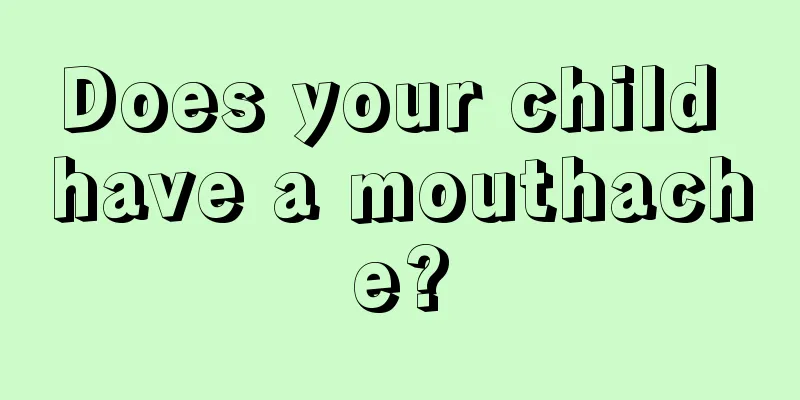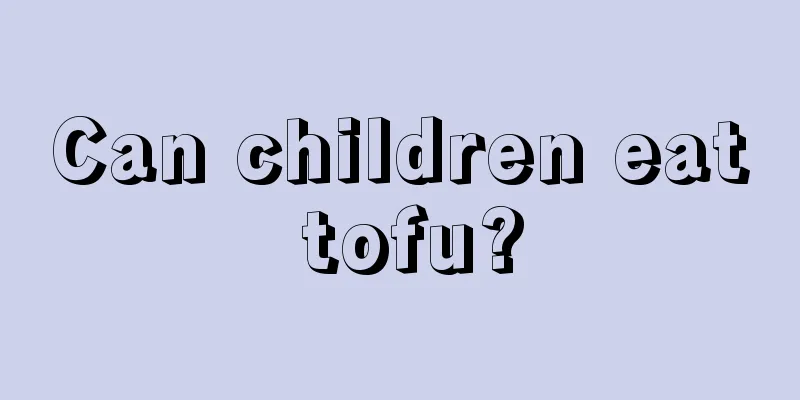Does your child have a mouthache?

|
If a child has a sore mouth, parents should pay attention to it. It may be angular cheilitis, or it may be related to the baby's usual diet. Parents should not feed the baby spicy or fried food, and should give the baby more fresh vegetables and fruits. If the pain is severe, it is best to take the baby to the hospital for examination. Symptoms of angular cheilitis 1. Malnutrition-induced angular cheilitis: Malnutrition-induced vitamin B deficiency often causes angular cheilitis, especially the latter. It manifests as wet white spots on both sides of the mouth, with erosions or ulcers. There are horizontal fissures, which may extend to the inner mucosa or skin in severe cases. The depth and length of the fissures vary, and the pain is not obvious. Angular cheilitis is often accompanied by dry lips, longitudinal cracks and occasional scales, and slightly swollen lips. The filiform papillae on the dorsum of the tongue atrophy to make the dorsum smooth, but the fungiform papillae are edematous, thickened, and mushroom-shaped. Scattered distribution, tooth marks are often seen on the edge of the tongue. The patient feels irritating pain at the corners of the mouth. Therefore, malnutrition-induced angular cheilitis not only causes erosion of the corners of the mouth but also cheilitis and glossitis. Nutrition and vitamins should be supplemented. 2. Bacterial angular cheilitis: including those caused by streptococcal and staphylococcal infections. When the distance between the upper and lower jaws is shortened, saliva often collects at the corners of the mouth. When the body's resistance is low, bacterial infection often occurs, which is more common in elderly edentulous patients. Its clinical manifestations are similar to those of malnutrition-induced angular cheilitis, with erosion, swelling at the corners of the mouth, and transverse cracks being the main symptoms. If combined with bacterial infection, local suppuration, bleeding, and induration may occur. Treatment is mainly with broad-spectrum antibiotics. The mouth area should be cleaned before topical medication, and systemic medication should be applied if necessary. 3. Fungal angular cheilitis: Angular cheilitis caused by fungal infection is called fungal angular cheilitis, which is mainly caused by Candida albicans infection. Fungal infection often occurs when the body's resistance is low and under local moist conditions. It is similar to bacterial angular cheilitis, but the local area appears whiter, and signs of fungal infection in other parts of the body can often be seen. The differentiation from bacterial angular cheilitis is mainly based on culture smears and PAs staining, and a clear diagnosis can be made when Candida hyphae are found. The treatment should first improve the body's resistance, clean the area with nystatin solution, and then apply nystatin or cyclisamide or miconazole preparations after drying. What causes angular cheilitis in children? 1. What causes angular cheilitis in children? First of all, malnutrition is an important cause of angular cheilitis. Therefore, children in some remote and impoverished mountainous areas are more likely to suffer from angular cheilitis. The living conditions there are not good, and a lack of vitamin B can also easily cause angular cheilitis. Please pay attention. Second, not paying attention to oral hygiene can also lead to angular cheilitis. Therefore, whether from a preventive perspective or a treatment perspective, ensuring oral hygiene is the key. We must urge children to rinse their mouths and brush their teeth frequently, and then keep the skin around their mouths moisturized. Finally, some diseases can also cause angular cheilitis. For example, atopic dermatitis may cause angular cheilitis, and uneven teeth may also cause angular cheilitis. Therefore, we must prescribe the right medicine and know the cause first before we can treat it well. 2. What to do if your child has angular cheilitis When children suffer from angular cheilitis, the area around the corners of their mouths becomes red and itchy, followed by erosion, cracks, and dryness and pain in the corners of their mouths. Some children often lick their lips with their tongues, and they feel "comfortable" after licking, but the saliva quickly evaporates, so they lick again. Because the lips are rich in blood vessels, they are conducive to the reproduction of microorganisms, which aggravates the symptoms of angular cheilitis, and the corners of the mouth are particularly painful when talking and eating. First of all, we should correct the child's bad habits of partiality and picky eating, let the child eat more vegetables and fruits, and eat more milk, animal offal, soy products and other foods rich in vitamin B2. Applying gentian violet at the corners of the mouth can promote local scab formation, you can also apply erythromycin ointment or anti-cracking oil on the corners of the mouth. If the symptoms are more severe, you can take vitamin C and vitamin B2 orally. |
<<: Occult blood in children's urine?
>>: What should a teacher do if a child lies?
Recommend
How to treat a two-month-old child with a cold and fever?
Children are usually susceptible to various disea...
Diarrhea, itchy rash
The gastrointestinal system carries all the diges...
What causes dizziness and headache in children?
According to statistics, more and more children h...
What happens when a newborn baby suddenly cries while sleeping?
Children do not have good expressive ability. Whe...
What foods can cause precocious puberty in children?
Children's growth and development is the topi...
How to treat tooth decay in children?
Many children like to eat sweet foods, especially...
Why is my two-month-old baby breathing fast?
If a two-month-old baby has difficulty breathing ...
ADHD Consequences
I believe that if a parent finds out that his or ...
Do children need to be given injections if they bite someone?
Children's emotions are difficult to control ...
What to do if a seven-year-old child has repeated fevers
As children grow up, they will always experience ...
What are some appetizer recipes for 2-year-old babies?
Nowadays, material living conditions are getting ...
What to do if the baby refuses to eat milk when teething
Almost all mothers have had this experience: babi...
What are some recipes for children to grow taller?
The growth of children is always a concern for pa...
What to do if your child's skin is dry and itchy to make your baby more comfortable
The skin of many children will become very dry in...
What causes green stools in three-month-old babies?
Green stools are a common symptom of disease in t...









